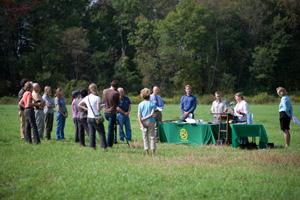September 24, 2009
Spotting the brownish-gray and orange shell of the wood turtle in hay fields or along the banks of rivers in Western Massachusetts these days has become an increasingly rare occurrence.
But not if Amherst College can help it.
 |
This summer, the college made an agreement with farmers leasing Amherst property to delay mowing this fall a strip of land along a small waterway that now serves as a buffer zone for the reptiles, who are officially recognized as a “species of special concern” by the state under the Massachusetts Endangered Species Act. The measure—which creates a safe habitat for the turtles to live and forage for food—could spare a significant number of them from premature deaths, said state officials Sept. 23.
The efforts by the college and the farmers to protect the animals were recognized that day by Massachusetts and federal agencies at an event that drew wildlife enthusiasts, members of the community and local media. (Read, watch or listen to stories about the event by The Republican and Daily Hampshire Gazette [registration required] newspapers or on 22 News and WAMC radio.) The gathering also spotlighted the wood turtle protection initiative, a voluntary program created by the U.S. Department of Agriculture’s Natural Resources Conservation Service (NRCS) and the Massachusetts Division of Fisheries and Wildlife’s Natural Heritage and Endangered Species Program, aimed at maintaining the reptiles’ habitat and reducing their mortality rates.
“We wanted to thank Amherst College for having the vision to preserve this habitat, and work with us,” said Christine Clarke, a conservationist with the NRCS, during the brief ceremony.
Administrators at the college became aware of the program this summer, when a state official alerted them of the wood turtles’ plight and asked them to leave a buffer zone for the animals. Whether or not to participate was a no-brainer, said James Brassord, director of facilities and associate treasurer for the college. “This program is entirely consistent with our work to preserve what wildlife habitats we can on campus, so we were on board from day one.”
Of the 1,000 acres of property in the town of Amherst that the college owns, he explained, about 800 acres are considered “open”—they are areas not developed because of conservation restrictions, agricultural development or just a simple commitment to keep them green. Many of those acres, Brassord added, are wildlife habitats for other animals, such as songbirds.
“We have our trustees to thank for their foresight in acquiring these properties over the generations,” said Brassord. “The local wildlife, as well the town of Amherst and our faculty, staff and students have benefited from their actions….As an institution, we have tried to set an example for our students in particular to be stewards of the land and protect our natural resources and, in this case, wood turtles. We’ve also been fortunate that our farm partners have been happy to do what they can for the animals too.”
Wood turtles live throughout New England—and on the Amherst campus—on the banks of streams, especially slower moving, mid-sized streams with sandy bottoms and heavily vegetated stream banks. Active from mid-March through October, the animals spend most of the spring and summer in fields, wet meadows, bogs and beaver ponds and then return to the streams in late summer or early fall for the colder months. It is in those fields and beyond that many turtles are killed by mowers, pollution, cars, pets and other things.
Now they’ll be safe on at least several acres of college property.
“This land is home to a great many wildlife species,” said Mary Griffin, commissioner of the Massachusetts Department of Fish and Game, citing birds, butterflies, fox and deer as a few examples. “We’re appreciative of the work that the college and these local farmers are doing to manage their land with both the people and the wildlife in mind.”